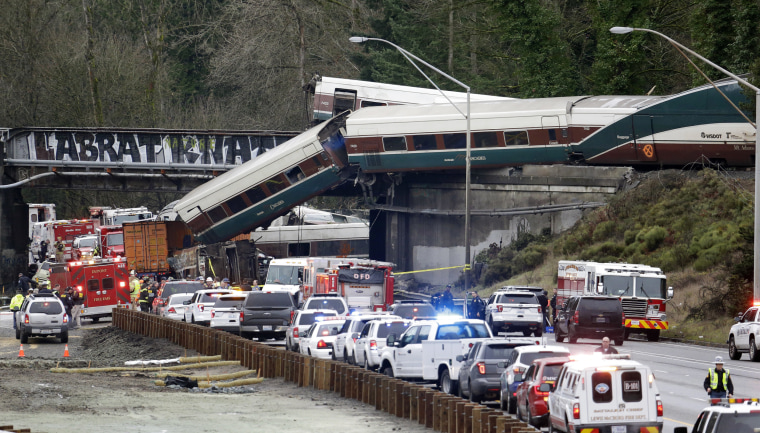The engineer at the helm of the controls in Monday's deadly Amtrak derailment in Washington state will be a vital figure in learning why the train failed to slow at a tight curve.
Federal investigators will seek to interview the engineer in order to piece together the doomed path of Train 501 of Amtrak's Cascades service, which officials said barreled at 80 mph on what was supposed to be a 30-mph stretch of track.
The engineer's identity has not been made public. That person along with the other crew members remain hospitalized and will be questioned in the next day or two, said Bella Dinh-Zarr, a National Transportation Safety Board member.
"We want to make sure they're well enough to be interviewed," Dinh-Zarr said early Tuesday on MSNBC.
At least three people were killed and dozens of others injured outside Tacoma during the train's inaugural trip between Seattle to Portland, Oregon.
Related: Local transit employee among those killed in Amtrak derailment
Dramatic footage from the scene showed a portion of the train — made up of 12 cars and two locomotives — dangling precariously from a bridge overpass. No motorists below were killed, according to officials.
The NTSB said late Monday it was "too early to tell" the cause, but investigators are mobilizing as they would with any major derailment. They'll have a number of resources and evidence to review in this complex case, including:
The engineer
Interviews with the engineer could yield answers to whether he or she was in full control of the train when it continued to speed. Did they see any warning signs posted, were the brakes working properly or did the engineer get distracted in some way?
They'll also ask the engineer about the condition of the track and whether there was anything unusual about it.
Amtrak prohibits its engineers from using their phone while the train is running. Investigators will look at the engineer's phone to see if it was in use.
They'll also take blood and urine samples to determine if the engineer was under the influence of drugs or alcohol — a standard course of action in any investigation.
Related: 'Positive Train Control' ordered by Congress, but not yet in place
A distracted engineer led to the Amtrak derailment in Philadelphia in 2015, when a train accelerated to 106 mph on a 50 mph curve, killing eight people and injuring about 200.
A federal investigation found the engineer likely lost "situational awareness" because of chatter over the radio. Involuntary manslaughter charges against him were dropped in September.
Larry Mann, a railroad safety attorney, said on MSNBC that fatigue remains a problem among engineers in the industry and is the largest single safety factor.
"I'm sure that the NTSB will investigate the workweek of this engineer to determine if he was fatigued," Mann said.
Black boxes
So far, one of two black boxes was recovered from the rear locomotive, Dinh-Zarr said. The information retrieved on it revealed that the train had been going 80 mph.
Besides speed, the data recorders can also tell investigators the position of the brakes and throttle and any mechanical issues.
Cameras
After the derailment in Philadelphia, Amtrak moved quickly to install inward-facing cameras in its locomotives after Washington lawmakers questioned why they weren't there. Previously, some trains only had outward-facing cameras.
The derailment site
About 20 investigators have been sent to the scene. They will work to preserve perishable evidence and probe train cars, the track and signals.
Other interviews, records
The train was carrying 80 passengers, three crew and two service personnel at the time of the derailment — all of whom would be interviewed as part of the investigation.
Mann said that if for some reason the engineer was not alert, other crew members would have theoretically warned him or her to slow down.
In addition, Dinh-Zarr said, investigators will comb through maintenance and inspection records related to the train and the signals.

